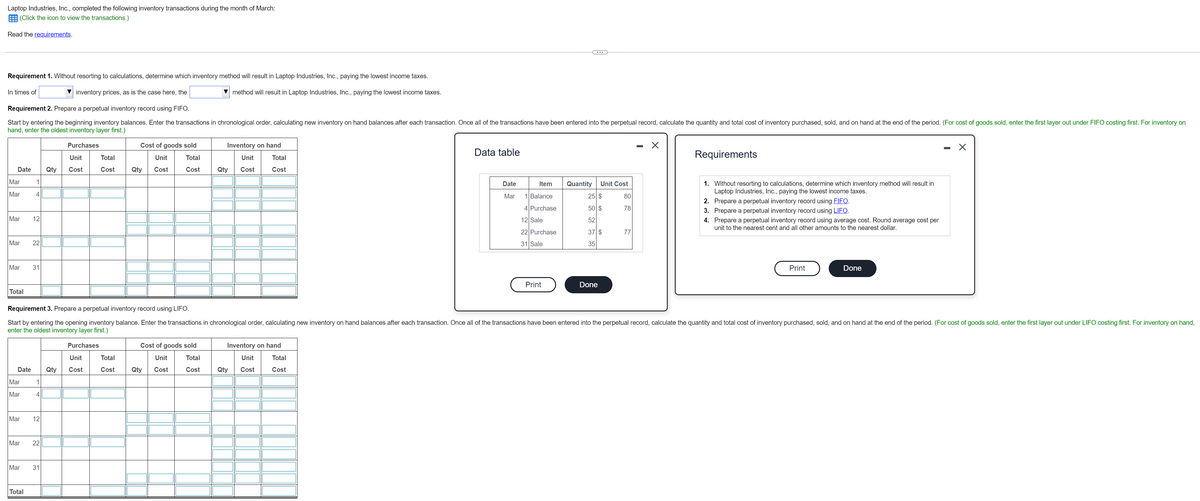4 12 22 opening inventory balance. Enter the fansactions Cost of goods sold Unit Cost Purchases Unit Oty Cost Total Cost Cost Inventory on hand Qty Cost Total
4 12 22 opening inventory balance. Enter the fansactions Cost of goods sold Unit Cost Purchases Unit Oty Cost Total Cost Cost Inventory on hand Qty Cost Total
Financial Accounting
15th Edition
ISBN:9781337272124
Author:Carl Warren, James M. Reeve, Jonathan Duchac
Publisher:Carl Warren, James M. Reeve, Jonathan Duchac
Chapter7: Inventories
Section: Chapter Questions
Problem 6PB: Data on the physical inventory of Katus Products Co. as of December 31 follow: Quantity and cost...
Related questions
Question

Transcribed Image Text:Requirement 4. Prepare a perpetual inventory record using average cost. Round average cost per unit to the nearest cent and all other amounts to the nearest dollar.
Start by entering the opening inventory balance. Enter the transactions in chronological order, calculating new inventory on hand balances after each transaction. Once all of the transactions have been entered into the perpetual record, calculate the quantity and total cost of inventory purchased, sold, and on hand at the end of the period. (Round average cost per unit to the nearest cent and all other amounts to the nearest dollar.
Purchases
Cost of goods sold
Inventory on hand
Unit
Total
Unit
Total
Unit
Total
Date
Qty
Cost
Cost
Qty
Cost
Cost
Qty
Cost
Cost
Mar
1
Mar
4
Mar
12
Mar
22
Mar
31
Total

Transcribed Image Text:Laptop Industries, Inc., completed the following inventory transactions during the month of March:
E (Click the icon to view the transactions.)
Read the requirements.
...
Requirement 1. Without resorting to calculations, determine which inventory method will result in Laptop Industries, Inc., paying the lowest income taxes.
In times of
inventory prices, as is the case here, the
method will result in Laptop Industries, Inc., paying the lowest income taxes.
Requirement 2. Prepare a perpetual inventory record using FIFO.
Start by entering the beginning inventory balances. Enter the transactions in chronological order, calculating new inventory on hand balances after each transaction. Once all of the transactions have been entered into the perpetual record, calculate the quantity and total cost of inventory purchased, sold, and on hand at the end of the period. (For cost of goods sold, enter the first layer out under FIFO costing first. For inventory on
hand, enter the oldest inventory layer first.)
Purchases
Cost of goods sold
Inventory on hand
Data table
Requirements
Unit
Total
Unit
Total
Unit
Total
Date
Qty
Cost
Cost
Qty
Cost
Cost
Qty
Cost
Cost
Mar
Quantity
1. Without resorting to calculations, determine which inventory method will result in
Laptop Industries, Inc., paying the lowest income taxes.
Date
Item
Unit Cost
Mar
4
Mar
1 Balance
25 $
80
2. Prepare a perpetual inventory record using FIFO.
4 Purchase
50 $
78
3. Prepare a perpetual inventory record using LIFO.
Mar
12
12 Sale
52
4. Prepare a perpetual inventory record using average cost. Round average cost per
unit to the nearest cent and all other amounts to the nearest dollar.
22 Purchase
37 $
77
Mar
22
31 Sale
35
Mar
Print
Done
Print
Done
Total
Requirement 3. Prepare a perpetual inventory record using LIFO.
Start by entering the opening inventory balance. Enter the transactions in chronological order, calculating new inventory on hand balances after each transaction. Once all of the transactions have been entered into the perpetual record, calculate the quantity and total cost of inventory purchased, sold, and on hand at the end of the period. (For cost of goods sold, enter the first layer out under LIFO costing first. For inventory on hand,
enter the oldest inventory layer first.)
Purchases
Cost of goods sold
Inventory on hand
Unit
Total
Unit
Total
Unit
Total
Date
Qty
Cost
Cost
Qty
Cost
Cost
Qty
Cost
Cost
Mar
1
Mar
Mar
12
Mar
22
Mar
31
Total
31
Expert Solution
This question has been solved!
Explore an expertly crafted, step-by-step solution for a thorough understanding of key concepts.
Step by step
Solved in 2 steps

Knowledge Booster
Learn more about
Need a deep-dive on the concept behind this application? Look no further. Learn more about this topic, accounting and related others by exploring similar questions and additional content below.Recommended textbooks for you

Financial Accounting
Accounting
ISBN:
9781337272124
Author:
Carl Warren, James M. Reeve, Jonathan Duchac
Publisher:
Cengage Learning


Financial Accounting
Accounting
ISBN:
9781305088436
Author:
Carl Warren, Jim Reeve, Jonathan Duchac
Publisher:
Cengage Learning

Financial Accounting
Accounting
ISBN:
9781337272124
Author:
Carl Warren, James M. Reeve, Jonathan Duchac
Publisher:
Cengage Learning


Financial Accounting
Accounting
ISBN:
9781305088436
Author:
Carl Warren, Jim Reeve, Jonathan Duchac
Publisher:
Cengage Learning


College Accounting, Chapters 1-27
Accounting
ISBN:
9781337794756
Author:
HEINTZ, James A.
Publisher:
Cengage Learning,

Financial And Managerial Accounting
Accounting
ISBN:
9781337902663
Author:
WARREN, Carl S.
Publisher:
Cengage Learning,